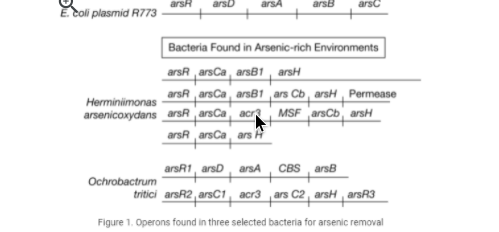Arsenic is a toxic element found in both aquatic and terrestrial environments. Scientists have found genes that allow bacteria to remove arsenic from their cytoplasm. Arsenic enters cells as arsenate that must be converted to arsenite to leave cells. Figure 1 provides a summary of the arsenic resistance genes found in the operons of three different bacteria. E. coli R773 is found in environments with low arsenic levels. Herminiimonas arsenicoxydans and Ochrobactrum tritici are both found in arsenic‑rich environments. Researchers claim that bacteria that live in environments heavily contaminated with arsenic are more efficient at processing arsenic into arsenite and removing this toxin from their cells. Justify this claim based on the evidence shown in Figure 1. Both H. arsenicoxydans and O. tritici contain the arsR gene that codes for a repressor that turns on the operon to eliminate arsenite from the cell. Both O. tritici and E. coli contain the arsD gene, which codes for a protein that helps remove arsenite from the cell. There are multiple operons controlling the production of proteins that process and remove arsenite from cells in both H. arsenicoxydans and O. tritici. In contrast, E. coli has only one operon devoted to arsenic removal. Both H. arsenicoxydans and O. tritici. have more arsenic resistance genes than has E. coli.
Bacterial Genomics
The study of the morphological, physiological, and evolutionary aspects of the bacterial genome is referred to as bacterial genomics. This subdisciplinary field aids in understanding how genes are assembled into genomes. Further, bacterial or microbial genomics has helped researchers in understanding the pathogenicity of bacteria and other microbes.
Transformation Experiment in Bacteria
In the discovery of genetic material, the experiment conducted by Frederick Griffith on Streptococcus pneumonia proved to be a stepping stone.
Plasmids and Vectors
The DNA molecule that exists in a circular shape and is smaller in size which is capable of its replication is called Plasmids. In other words, it is called extra-chromosomal plasmid DNA. Vectors are the molecule which is capable of carrying genetic material which can be transferred into another cell and further carry out replication and expression. Plasmids can act as vectors.

Trending now
This is a popular solution!
Step by step
Solved in 2 steps




